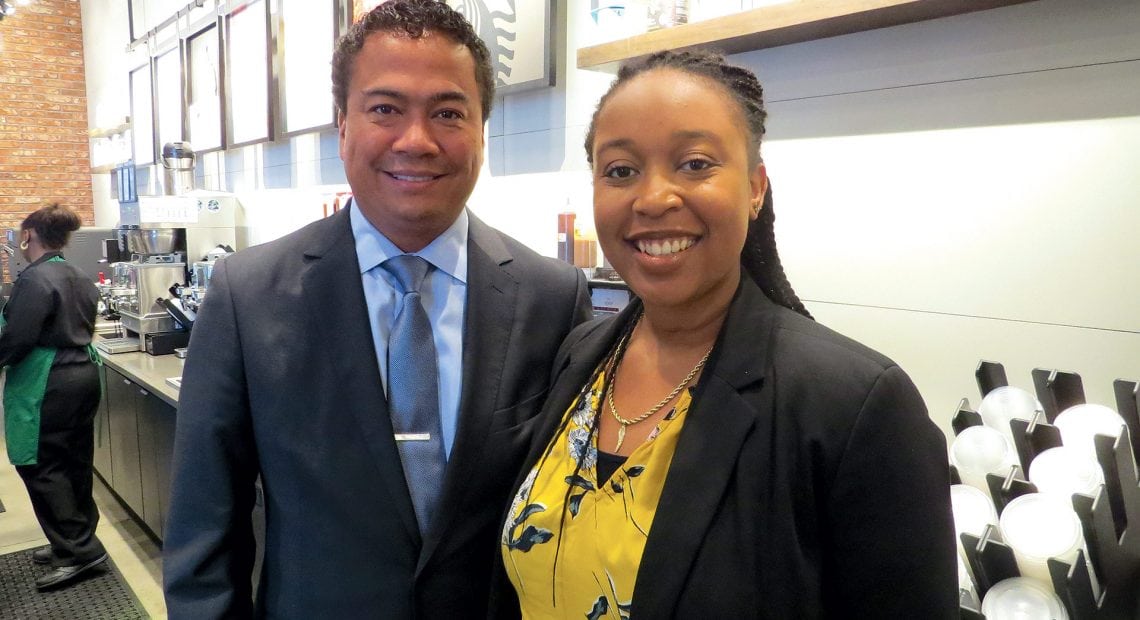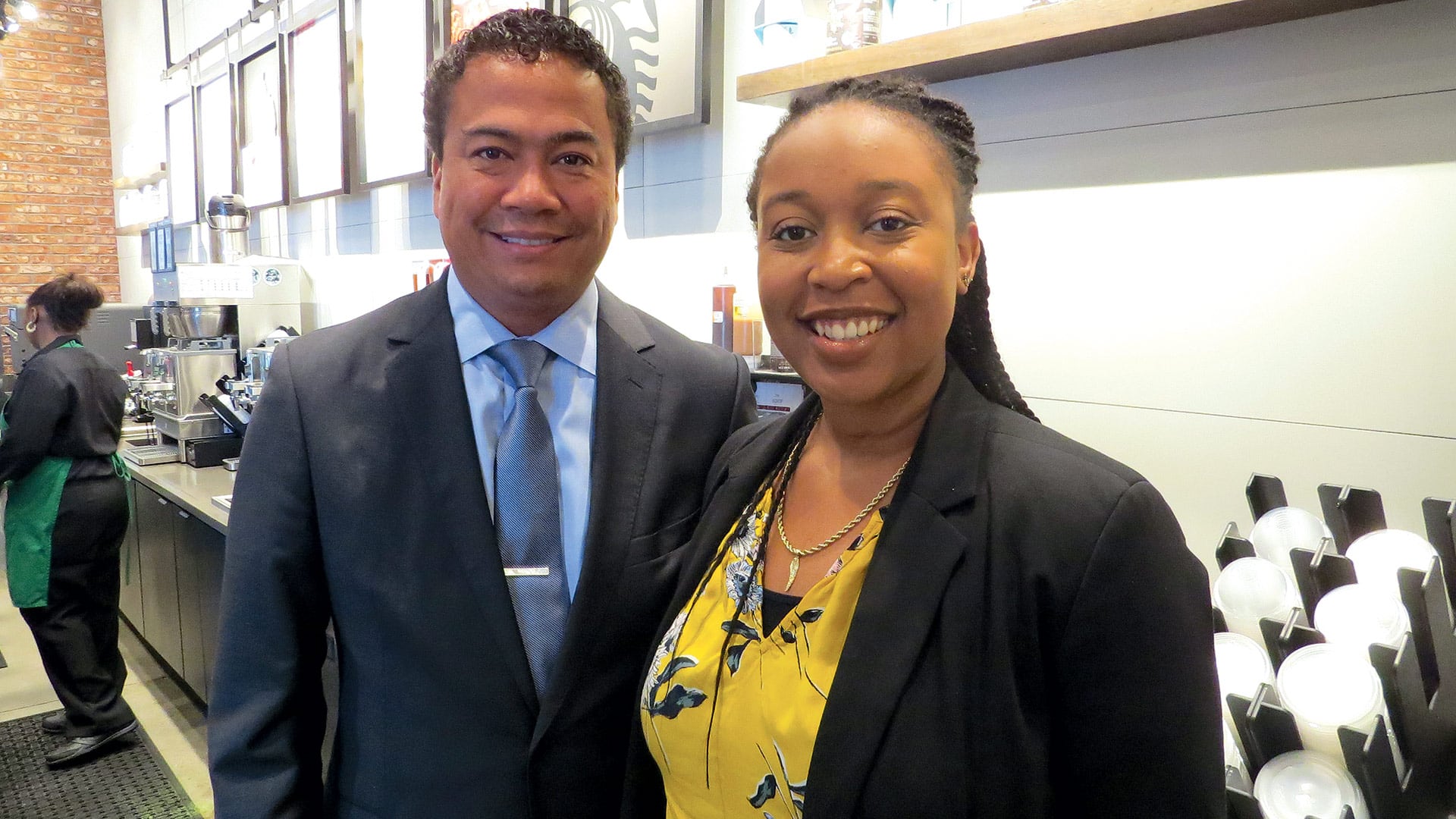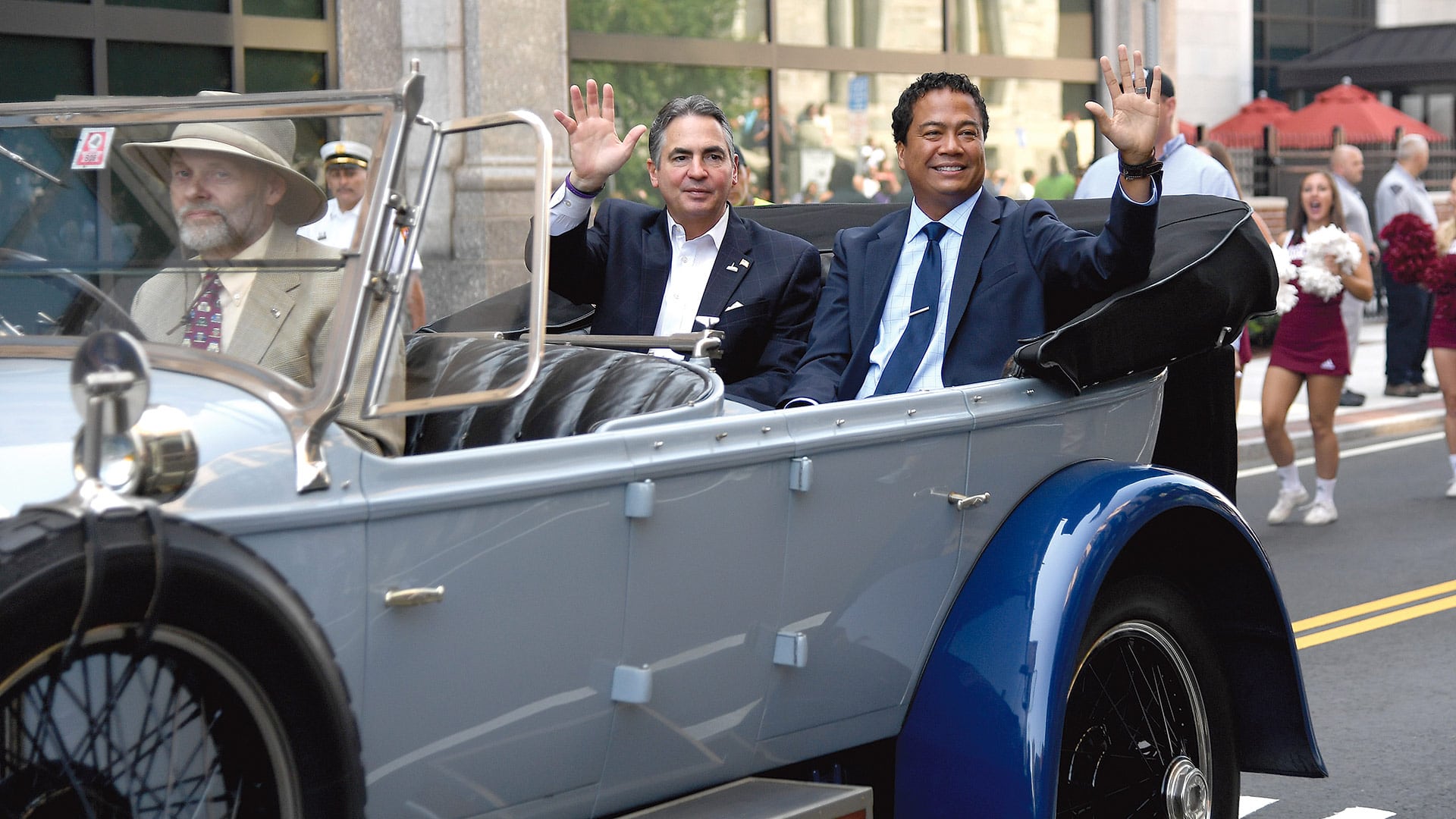
For Mike Mathis, It Was — and Is — All About the Journey
Looking at His Reflection

Mike Mathis, seen here with Anita Bird, assistant general manager of the Starbucks at MGM Springfield, says the $960 million initiative has gone from being a campaign and project to being an employer and operator.
When Mike Mathis rode down Main Street with Springfield Mayor Domenic Sarno in the back of a Rolls-Royce (built in the city) on Aug. 24, it was the symbolic end to a journey that began nearly six years earlier. Or one stage of it, anyway. Indeed, Mathis, president and COO of MGM Springfield, made it clear that the journey continues, personally and professionally, as the casino works over the next few years to ‘hit its stride,’ as he put it.
Mike Mathis said there were so many high points during the journey to opening the $960 million MGM Springfield that he was having some trouble listing and ranking some that stood out above the others.
As for low points, well, he didn’t have any trouble at all with that assignment.
There was one stood out well above the others, and it brought with it some lessons — and humility — that served him well for the rest of the sojourn that climaxed on Aug. 24 when the resort casino opened, but is still very much ongoing.
It came in the fall of 2015 as the design of the casino, and, more specifically, its hotel, changed considerably — from a 25-story glass tower that would dominate the skyline to a five-story facility along Main Street that would blend in. And especially at a hastily arranged press conference to announce the change and the days that followed.
Mathis, named president and COO of MGM Springfield roughly a year and a half before that day, looked uncomfortable and quite defensive at that press conference, called after news of the design change leaked out in the local press and spurred a reaction he and others within the company were not prepared for after years of doing business in Las Vegas and other locales where such design changes aren’t really news, let alone confidence-shattering developments.
“Some of our naysayers took advantage of that and accused us of a bait and switch,” Mathis recalled. “Meanwhile, some of the folks that were more pessimistic about what our intentions were — despite years of goodwill I thought we had earned — seized on that moment.
“It was almost a condition of … this community had seen such a tough run that even some of our supporters thought that maybe MGM is too good to be true — the commitment is too good to be true — and used that change to say, ‘I told you so.’ That was challenging on many levels for me personally and the team.”
“It was almost a condition of … this community had seen such a tough run that even some of our supporters thought that maybe MGM is too good to be true — the commitment is too good to be true — and used that change to say, ‘I told you so,’” he went on. “That was challenging on many levels for me personally and the team.”
Elaborating, he said that he and his team members were all very visible in those days — and throughout the process — and some of those they greeted on the streets in the days following the announcement made their feelings known.
“I got a lot of personal flak on the streets, some of it not so gracious,” he recalled. “But that was a very small window and from a small majority, and that’s what I kept telling myself. And we weathered that storm, and we got the right information out. We didn’t handle it perfectly by any means, and I told the mayor that, but we got past it.”
Indeed, and on Aug. 24, Mathis and Mayor Domenic Sarno shared an energetic high-five as they opened the doors to the casino complex just before 11 a.m., capping a six-year journey that actually began in Brimfield, not Springfield, as some may recall.
Or at least the first part of the journey.

Mike Mathis says it takes two to three years for a facility like MGM Springfield to fully “ramp up.”
Building and opening the casino was obviously a long and difficult assignment, but it was just a step in the process, said Mathis, who told BusinessWest that MGM Springfield has gone from being a campaign and a project (one that officially ended on Aug. 24) to being an employer and an operator. And with that change, there are new responsibilities — for him and the team.
“That means thinking about the customer first, and everything flows from that,” he explained, adding that one of the things he’s most proud of to date is how the workforce, much of it without any experience working in gaming, has progressed. “There’s so much you can overcome in our industry with a positive attitude, and that’s been really gratifying to see.”
For this issue, BusinessWest talked with Mathis, clearly the face of MGM Springfield, about the journey he’s on — the parts have been completed and the ones still to come.
A Solid Bet
As noted earlier, when Mathis, then vice president of Global Gaming Operations for MGM’s hospitality division, first arrived on the scene in Western Mass. with the goal of helping the company win one of the coveted casino licenses in the Bay State, the focus wasn’t on Springfield, but tiny Brimfield.
That’s where Mathis, who described himself as the “MGM advance Massachusetts guy,” first touched down and commenced learning all about Massachusetts politics, zoning, and more.
Eventually, he and the team would learn some other things — primarily that a Turnpike exit needed to make a Brimfield casino happen was not in the cards, as they say in this business, and also that Brimfield residents weren’t very responsive to the idea of having a project of this scale in their proverbial backyard.
“We mistakenly thought, because they host the antiques fair a few times a year that brings in hundreds of thousands of people a year, that they would be receptive to this attraction,” he recalled. “What we learned is that they like that a few times a year — to let their town get taken over — but they weren’t looking for that 365 days a year.”
Mathis and the team at MGM would learn many other things in the weeks, months, and years to come, especially the fact that they were not in Las Vegas anymore, and that things move much more slowly in the Bay State.
They also learned a lot about Springfield, which, in the early going, was emerging as a competitor to Brimfield. And the more they learned, the more they came to like the city and understand that whichever proposal emerged from the City of Homes would be a formidable candidate for the Western Mass. license.
Fast-forwarding a little, by late 2013, MGM’s plan to place a resort casino in Springfield’s South End was the only Western Mass. proposal still on the table after voters in West Springfield and Palmer rejected casino referendums and officials in Springfield chose the MGM option over two others placed into contention.
But still the fight wasn’t over, as MGM had to withstand a statewide referendum bid to ban casinos in November 2014, which it did, when 59% of voters gave the go-ahead to commence the casino era.
All that was left now was to design and build the facility, staff it up, meet a host of conditions set by the city and the Mass. Gaming Commission, and eventually open the doors.
“I remember the humility of Jim Murren walking into his [Sarno’s] office and saying, ‘mayor, we do these all the time, but we want to make sure we understand what your goals are before we even think about what we want to do here.”
Mathis, of course, was involved in every step of the process, and he recalls it as the most challenging but ultimately rewarding experience in his career.
“Seeing crowds enjoy this product that we created out of thin air, and seeing it serviced by a bunch of my friends and supporters and volunteers that I’ve been with since we were knocking on doors back in 2012 and 2013 … that’s as good as it gets,” he told BusinessWest. “That’s been the highlight of my career.”
As he looks back on that process, dozens, if not hundreds, of memories float to the surface — from attending neighborhood council meetings across Springfield to working with volunteers to summon the votes to defeat the ballot initiative on gaming, to visiting the Springfield Armory with MGM Chairman Jim Murren to learn about city history and architecture, and especially the influence of Frederick Law Olmstead, who designed not only Central Park in New York but Forest Park in Springfield.
And, yes, that uncomfortable press conference when the design change was announced.
Early on the in the process, when Mathis was still on the advance team and not yet the face of the project, he recalls watching senior-management members as they worked to develop a relationship with Springfield and its leaders — and learning from those experiences.

Mike Mathis and Springfield Mayor Domenic Sarno ride in style on opening day of MGM Springfield — in a Rolls-Royce made in the city — at the symbolic end of a journey that began six years ago. Getty Images
“My memory from those early days was how important it was for the chairman of our company to really understand what the mayor wanted,” he recalled. “I remember the humility of Jim Murren walking into his [Sarno’s] office and saying, ‘mayor, we do these all the time, but we want to make sure we understand what your goals are before we even think about what we want to do here.’”
All In
Actually, MGM doesn’t really do this all the time. It opened National Harbor in Maryland in late 2016, and another casino in Detroit a few years earlier. But it hasn’t opened many in this country, and hadn’t opened anything in the middle of an urban area like downtown Springfield.
So this was a pioneering effort in many ways, and for Mathis, who had previously done considerable work for the company overseas, in locales ranging from Singapore to Toronto, it was, quite obviously, a significant career stepping stone to be put in charge of it all.
To put that in perspective, he flashed back to the Gaming Commission session in early 2014 (he easily summoned the exact date, Jan. 24), when he was announced as the president of the project.
“There was a huge round of applause, and I recognized some of the voices in the audience saying ‘attaboy,’ and that was based on some of the relationships I had formed over the two years before that,” he recalled. “It was a special moment, and it really cemented for me how important this project was going to be for not just the company but the community, and they saw me as the face of it. And I thought that I owed them personally to deliver on the commitment; there was no way I was going to let these people down.”
He said the biggest challenges involved with coming to a new market like Massachusetts is understanding the local population’s experience with gaming, and its wants, needs, perceptions, and fears.
“We would go into neighborhood meetings and ask how many people had been to Las Vegas,” he recalled. “And not many had, and that told me that, to the extent that they know gaming, they know it in a regional way, and they don’t know some of the great things we do in Las Vegas, a lot of which is MGM.
“And that gives you some perspective on the group and the level of education you have to give them,” he went on. “Because I knew what the fear was — the fear was a slot box that would be cavernous and unimaginative and prey on the worst elements of the business. Overall, you have to identify with people on a very personal level and overcome some of the stereotypes people have from watching movies about what a casino operator is.”
Now that MGM Springfield is open, there’s been that shift he described, going from being a project to an operation. For him, the day-to-day is obviously much different, with a great deal of time spent on the casino floor.
“I view my role, especially in this early stage, as being quality assurance,” he explained. “I try to put on the eyes of the customer and walk through every space and observe every interaction.”
I do so with the mindset, ‘what is the customer experiencing, from the minute they enter our garage, or even further downstream — what are they experiencing as they travel on I-91 or the Turnpike?’” he went on. “‘What are they seeing for signage? What are they seeing in terms of access and traffic?’ These are all things I’m trying to see from their perspective.”
He said he will frequently engage patrons, asking them about their experience, their meal, and more. And many times, they’ll engage him because they recognize him from all those times he’s been in the news — and walking around the city, through the good times and the bad.
That’s when happens when you’re the face of the operation.
As for MGM Springfield as an operation, not a project, he said that, overall, it takes two to three years for a resort casino like this one to “hit its stride,” as he put it.
“That’s the typical ramp-up,” he went on. “There’s a lot of runway for us to do more business and more profitable business moving forward, especially as understand our staffing patterns, our peaks and valleys throughout the week and throughout the season, and what the customer wants and doesn’t want.”
Next Question
When asked what comes next for him — a prolonged stay in Springfield, a new assignment in another corner of the world, or something in between — Mathis said he really hasn’t had any time to think about that.
“The journey was amazing, and I’d be worried about trying to replicate it — if I could replicate it,” he explained. “This has been pretty unique, and it would be a mistake to think I could find another Springfield and do what we did here.”
And with that, he went back to the casino floor to engage customers and be engaged by them.
The journey has, indeed, been amazing, but in most all respects, this trip is far from over.
George O’Brien can be reached at [email protected]





